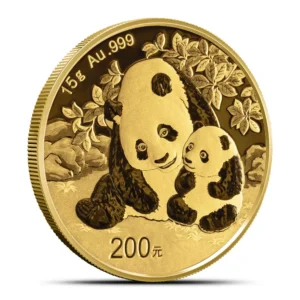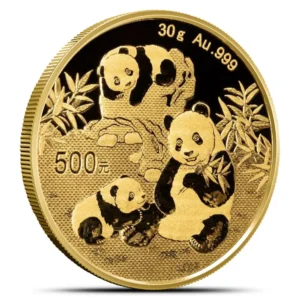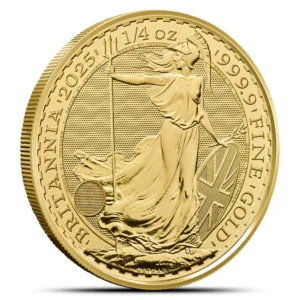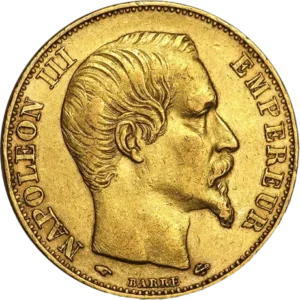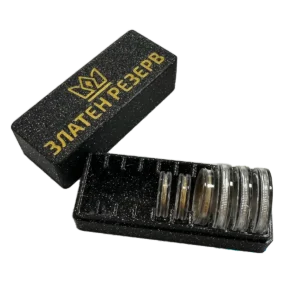The People’s Bank of China is the official name of the Chinese central bank. Under their guidance, the China Gold Coin Incorporation (CGCI) produces Panda bullion coins in gold and silver on an annual basis.
The design of the Panda changes on each year, but the coins always feature the Temple of Heaven and the year of production on the obverse side. Chinese Panda coins are produced in metric format rather than traditional imperial, meaning investors and collectors can get 1g, 3g, 8g, 15g, and 30g bullion coins.
Showing all 2 resultsSorted by popularity
The Legacy of China Mint
The China Mint, overseen by The People’s Bank of China, has a rich history of producing exquisite coins since 1982. Its dedication to quality and precision makes it a global leader. Every coin reflects centuries of Chinese culture and meticulous craftsmanship. From gold coins to commemorative pieces, the Mint is celebrated worldwide for its artistry and trustworthiness.
The History of the Chinese Gold Panda Coin
The Chinese Gold Panda Coin debuted in 1982 and quickly became a collector’s favorite. Known for its iconic panda design, each year showcases a new, intricate image of this beloved creature. These coins are 99.9% pure gold, making them both a secure investment and a stunning collectible. Their limited mintage enhances their appeal, making them highly sought-after worldwide.
Why Choose People’s Bank of China Gold Coins?
- Investment Security: Backed by the Chinese government, these coins are a safe, reliable asset.
- Artistic Value: Each coin features intricate designs, celebrating Chinese culture and nature.
- Global Recognition: Renowned for quality and purity, these coins are prized across the world.
Variations in Weight and Denomination of the Chinese Gold Panda Coin
The coining history of the Chinese Gold Panda coin is arguably the most complex of any coin. As mentioned above, the Gold Panda debuted in 1982 with four weights and gained a fifth in 1983. Since then, the Chinese Mint has issued these five coins annually, but the designs of the Giant Panda on the reverse are the not only elements which have changed with time. The original 1 oz, 1/2 oz, 1/4 oz, 1/10 oz, and 1/20 oz coins had the following denominations (Yuan) from 1982/83 to 2000:
- 1 oz – 100 Yuan
- 1/2 oz – 50 Yuan
- 1/4 oz – 25 Yuan
- 1/10 oz – 10 Yuan
- 1/20 oz – 5 Yuan
In 2001, the Chinese Mint altered the denominations of the coins to feature the following face values by weight:
- 1 oz – 500 Yuan
- 1/2 oz – 200 Yuan
- 1/4 oz – 100 Yuan
- 1/10 oz – 50 Yuan
- 1/20 oz – 20 Yuan
The changes in the denomination issued on each coin were not the only ones to occur with time. More recently, the Chinese Mint made a significant change to the Chinese Gold Panda by removing Troy ounces as the unit of measurement marked on the coin. Instead, all Chinese Gold Panda coins issued after 2016 have weights marked in Grams on the coin. This, the Chinese Mint says, is to bring the coins in line with the nation’s use of the Metric system. The weights changed to the following markers:
- 1 oz – 30 Gram
- 1/2 oz – 15 Gram
- 1/4 oz – 8 Gram
- 1/10 oz – 3 Gram
- 1/20 oz – 1 Gram
The changes in weight measurements did not impact the denominations the Chinese Mint switched to in 2001 for the Gold Pandas. While all five weights maintained the same thickness of the coin, the switch to Grams evened out the weights with the 1 oz, 1/2 oz, 1/10 oz, 1/20 oz coins dropping slightly in total weight from previous measurements. The 1/4 oz coin actually gained some weight going from 7.7758 Grams as a 1/4 oz coin to an even 8 Grams under the new unit of measurement.
Finally, the diameter of the coins was altered slightly as well with the switch to Grams. Only the 1/2 oz coin maintained a diameter of 27.00 mm. The 1 oz and 1/20 oz coins shrunk slightly from their original diameters, while the 1/4 oz and 1/10 oz coins increased diameter slightly.
Are There Collectible Chinese Gold Panda Coins?
Ideal for Collectors and Investors
Whether you’re a seasoned investor or a passionate collector, these coins offer immense value. Add them to your portfolio to preserve wealth or gift them to commemorate special occasions.



